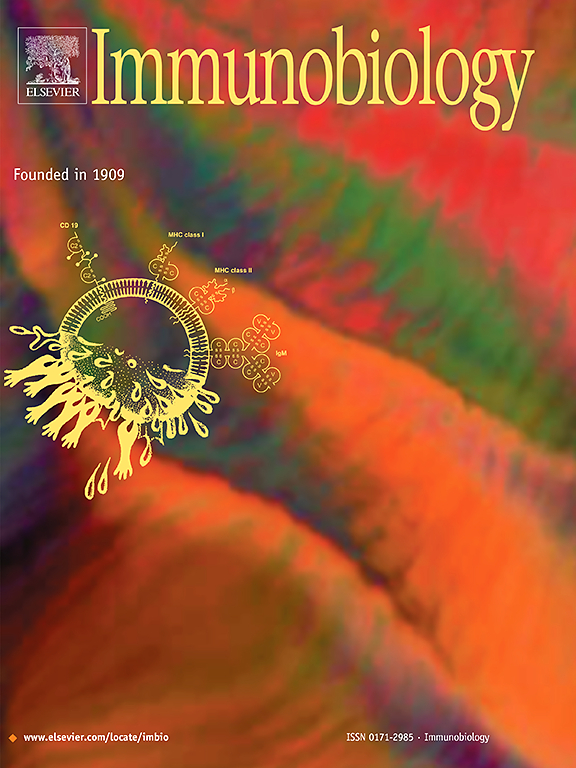APOE通过调节肿瘤微环境中CCL5/CCR5信号和诱导M2巨噬细胞极化驱动胶质瘤进展
IF 2.3
4区 医学
Q3 IMMUNOLOGY
引用次数: 0
摘要
肿瘤相关巨噬细胞(tam)在癌症进展过程中塑造肿瘤微环境(TME)中起着关键作用。新的证据表明,癌细胞中关键信号通路的失调驱动各种细胞因子的分泌,从而调节tam的功能。本研究旨在探讨胶质母细胞瘤细胞如何调节巨噬细胞,建立有利于肿瘤免疫逃逸的TME。方法在之前的生物信息学研究中,我们在胶质母细胞瘤患者中发现了异常表达的基因。其中,代谢相关蛋白APOE引起了特别的关注。我们制备了APOE表达改变的U87和U251细胞系,分别通过scratch法、Transwell法和ELISA法评估癌细胞的侵袭、迁移和炎症细胞因子的分泌。此外,我们建立了癌细胞和单核细胞THP-1共培养系统,利用流式细胞术、Western blot和免疫荧光技术评估shAPOE肿瘤细胞对巨噬细胞极化的影响。结果敲低APOE可显著降低U87和U251细胞的生存能力、侵袭能力和迁移能力。ELISA结果还显示,APOE敲除细胞分泌较高水平的IL-6、IL-12和TNF-α,而CCL5和TGF-β分泌明显减少。在巨噬细胞研究中,我们观察到APOE敲低改变了THP-1单核细胞的M1/M2极化比,CCR5抑制进一步降低了M2巨噬细胞的比例。免疫荧光分析显示M2巨噬细胞的减少依赖于APOE和CCL5。结论APOE下调可抑制胶质母细胞瘤细胞的迁移、侵袭和CCL5分泌,同时促进肿瘤抑制因子的产生。本文章由计算机程序翻译,如有差异,请以英文原文为准。
APOE Drives Glioma Progression by Modulating CCL5/CCR5 Signaling in the Tumor Microenvironment and Inducing M2 Macrophage Polarization
Background
Tumor-associated macrophages (TAMs) are pivotal in shaping the tumor microenvironment (TME) during cancer progression. Emerging evidence indicates that dysregulation of key signaling pathways in cancer cells drives the secretion of various cytokines, modulating TAMs function. This study aimed to explore how glioblastoma cells regulate macrophages and establish a TME conducive to tumor immune escape.
Methods
In previous bioinformatics studies, we identified abnormally expressed genes in glioblastoma patients. Among them, the metabolism-related protein APOE garnered particular attention. We generated U87 and U251 cell lines with altered APOE expression to evaluate cancer cell invasion, migration, and inflammatory cytokine secretion through scratch assays, Transwell assays, and ELISA, respectively. Additionally, we established a co-culture system of cancer cells and monocytes THP-1 to assess the impact of shAPOE tumor cells on macrophage polarization using flow cytometry, Western blot, and immunofluorescence techniques.
Result
Knockdown of APOE significantly reduced the viability, invasion, and migration capabilities of U87 and U251 cells. ELISA results also showed that APOE knockdown cells secreted higher levels of IL-6, IL-12, and TNF-α, while CCL5 and TGF-β secretion was markedly reduced. In macrophage studies, we observed that APOE knockdown altered the M1/M2 polarization ratio in THP-1 monocytes, with CCR5 inhibition further decreasing M2 macrophage proportions. Immunofluorescence analysis revealed that the reduction of M2 macrophages was dependent on APOE and CCL5.
Conclusion
Our findings indicate that APOE knockdown suppresses glioblastoma cell migration, invasion, and CCL5 secretion, while enhancing the production of tumor-suppressive cytokines.
求助全文
通过发布文献求助,成功后即可免费获取论文全文。
去求助
来源期刊

Immunobiology
医学-免疫学
CiteScore
5.00
自引率
3.60%
发文量
108
审稿时长
55 days
期刊介绍:
Immunobiology is a peer-reviewed journal that publishes highly innovative research approaches for a wide range of immunological subjects, including
• Innate Immunity,
• Adaptive Immunity,
• Complement Biology,
• Macrophage and Dendritic Cell Biology,
• Parasite Immunology,
• Tumour Immunology,
• Clinical Immunology,
• Immunogenetics,
• Immunotherapy and
• Immunopathology of infectious, allergic and autoimmune disease.
 求助内容:
求助内容: 应助结果提醒方式:
应助结果提醒方式:


